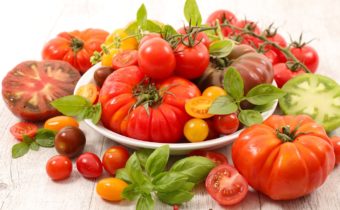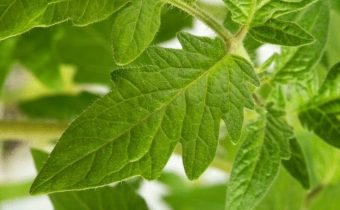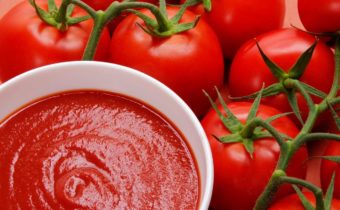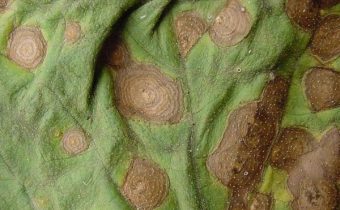Brown dry spot on the leaves of a tomato, how to treat macrosporosis (Alternaria)
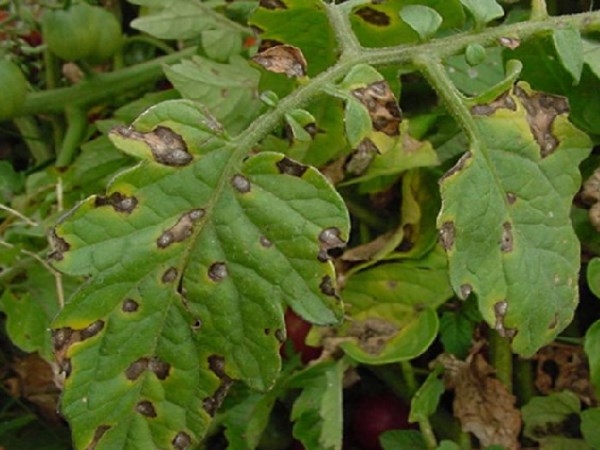
A common disease of tomatoes is Alternaria or dry spotting. The disease affects plants in greenhouses, at least in the beds in the open air. Without timely treatment, the presentation of the fruit and its taste are worsening, and the yield is sharply reduced.
Biology of the pathogen Alternaria
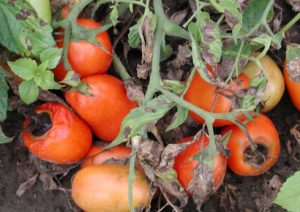
The causative agent of infection is a deuteromycete Alternatio solani Sorauer fungus. It parasitizes many plants of the nightshade family, spreads through the air, through drops of moisture (during watering, rains).
The pathogen develops in a humid environment at a temperature of + 20 ° C ... + 27 ° C, gray conidia are formed in conidiophores. The mycelium penetrates plant tissue, and only the anamorphic (asexual) stage of development is noted in the cycle. Damage to tomatoes is possible on any period of vegetation, the incubation period is from three to four days.
In the southern regions, Alternaria (macroscoporosis, Alternaria blotch) under favorable conditions appears early, already two weeks after transplanting.
Causes of the disease
Dry blotch appears in greenhouses and on ridges with plantings under certain conditions:
- high air temperature;
- high humidity;
- waterlogging;
- abundant dew.
The fungus develops in plant debris, survives the cold period in the form of conidia and mycelium. Transmitted through infected seeds.
Pathogen - deuteromycete Alternatio solani Sorauer does not reproduce in rotten plant debris.
In favorable conditions, phytophtora manifest before. It differs from blight by the fact that the spots remain dry even in heavy rains. Severe outbreaks of the disease in some years were noted in the North-West of the Russian Federation, in the Far East.
Risk factors are:
- night and day temperature drops;
- abundant dew;
- mechanical damage to the fruit.
There is a form of Alternaria, which affects not only mature, but also green tomatoes.
Symptoms of dry blotch
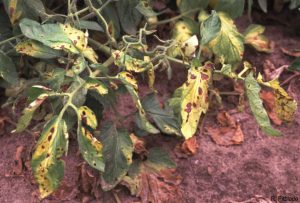 Spots appear everywhere, but at the initial stage, the lower leaves of tomatoes are most often the first to be affected. On the surface of the leaf plates are formed round brown specks, with a clear border and velvet coating (conidia). Sizes of spots - from 7 to 15 mm.
Spots appear everywhere, but at the initial stage, the lower leaves of tomatoes are most often the first to be affected. On the surface of the leaf plates are formed round brown specks, with a clear border and velvet coating (conidia). Sizes of spots - from 7 to 15 mm.
With the defeat of the stems and petioles of tomatoes, elongated spots of brown-black color are formed, with the defeat of the fruit - black formations pressed into the flesh. The fungus develops, the spots increase in size, capture an increasing area.
From one tomato bush, the infection spreads to others, gradually affecting the green aboveground parts of the plants. Transition of the disease to the epidemic stage threatens with massive losses of tomatoes.
Mycelium grows in the tissue of the fruit, the tomatoes change color, dark spots appear on the skin. Gradually the flesh darkens, the fungus captures the entire contents of the tomatoes, the fruits become unsuitable for food.
Damaged fungus vegetables grow small, showered.The infection infects the seeds in the pulp of tomatoes, therefore seed from such fruits cannot be taken. Without taking prompt measures of treatment, the leaves of the stems turn brown and dry, which ultimately leads to the death of the plantings.
Prevention measures for Alternaria
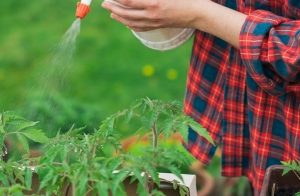 It is easier to prevent any diseases than to look for effective methods of plant treatment in the future. Basic preventive measures:
It is easier to prevent any diseases than to look for effective methods of plant treatment in the future. Basic preventive measures:
- purchasing healthy seedlings;
- mandatory pre-sowing seed preparation (treatment in solutions of potassium permanganate, fungicides);
- the alternation of crop planting at the site (it is recommended to return tomatoes to their former place no earlier than in 3-4 years);
- do not plant potatoes next to a tomato greenhouse, as alternarioz proceeds from one crop to another;
- be sure to air shelters, on hot days open vents, doors;
- after irrigation, loosen the soil, use mulch;
- observe the planting schemes for tomato bushes;
- shed the soil in the greenhouses in spring with solutions of potassium permanganate and copper sulfate for disinfection;
- remove plant residues from the beds;
- choose varieties that are resistant to dry blotch: Sanka, Nadezhda F1, Lyana, Golden Bullet, Alex F1, Aurora F1.
Having noticed the first signs of infection of plants, it is necessary to immediately treat the tomatoes with special solutions. Biological preparations are effective in the initial stages, but if the infection is noticed late and the disease has affected a large area of planting, tomatoes are treated with chemical preparations.
The use of biological agents in the fight against Alternaria
Biological preparations are used to protect against the spread of dry spot on tomatoes:
- Trichodermin;
- Fitolavin;
- Fitosporin-M;
- Alirin B.
These drugs suppress dangerous microflora, inhibit the fungus Alternatio solani Sorauer.
Trichodermin
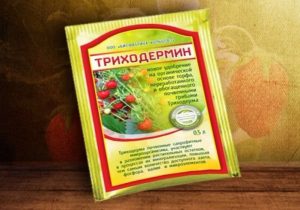 The product contains strains of beneficial fungus, as well as a special complex of metabolites (soil microflora). Used for seed treatment (prepare 2% solution), for spraying tomatoes (1% solution).
The product contains strains of beneficial fungus, as well as a special complex of metabolites (soil microflora). Used for seed treatment (prepare 2% solution), for spraying tomatoes (1% solution).
Spraying begins two to three weeks after transplanting, treated 3-4 times per season, the interval is two weeks.
Fitolavin
The basis of the drug - substances produced by soil fungi. Water the plants with a solution: 20 ml in a bucket of water. For the season - no more than two treatments, the interval is two weeks.
All working solutions are prepared immediately before use.
Fitosporin-M
Effective biofungicide for the prevention of Alternaria, treatment of plants in the early stages of infection. Spray the tomatoes with a solution: 5 g per 10 liters of water. Frequency of use: once every 10-14 days.
The use of chemicals in the fight against Alternaria
Effective treatment of plants with fungicides from the group of copper compounds, triazoles. Good results are obtained by systemic type fungicides, but in any case it is required to strictly observe the dosage and time of treatments.
Is fast
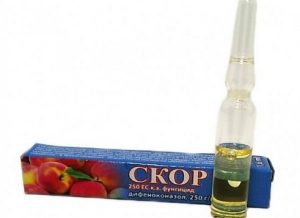 Available in ampoule form, in bottles. Active ingredient - difenokonazol, absorbed by all parts of plants.
Available in ampoule form, in bottles. Active ingredient - difenokonazol, absorbed by all parts of plants.
Effective in the early stages, used in the form of a solution: 10 ml of the drug is diluted in a bucket of warm water.
The processing rate per bush is 1 liter.
Kvadris
The product is based on the active ingredient azoxystrobin, which blocks the access of oxygen to the pathogen spores. Microorganisms gradually stop development and die.
Protective effect - up to three weeks.
The treatment is carried out with a 0.1% solution, the frequency - every 14-16 days. In season, spray tomatoes 3-4 times.
Ditan
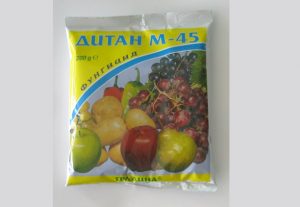 In the treatment of tomatoes for Alternaria at the advanced stage, Ditan, a contact fungicide, shows a good result.
In the treatment of tomatoes for Alternaria at the advanced stage, Ditan, a contact fungicide, shows a good result.
The active substance - mancozeb, is available in powder form. Tomatoes are used after treatments with Revus or Scor, to consolidate the effect. Diluted in water, observing the dosage according to the instructions.
It is also recommended to use the tools Acrobat, Title, Fital, Metaxil.
Alternaria is dangerous at any stage; therefore, preventive treatments should be carried out and crop culture should be observed. In the event of a disease, special preparations are used to get rid of the disease and preserve the harvest.


